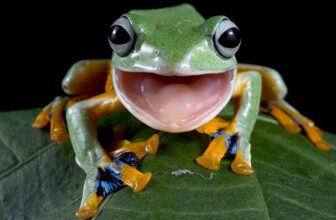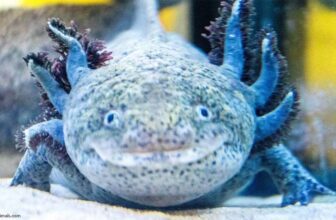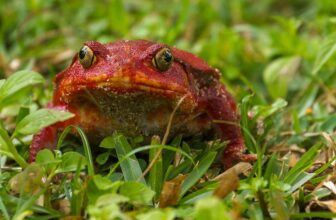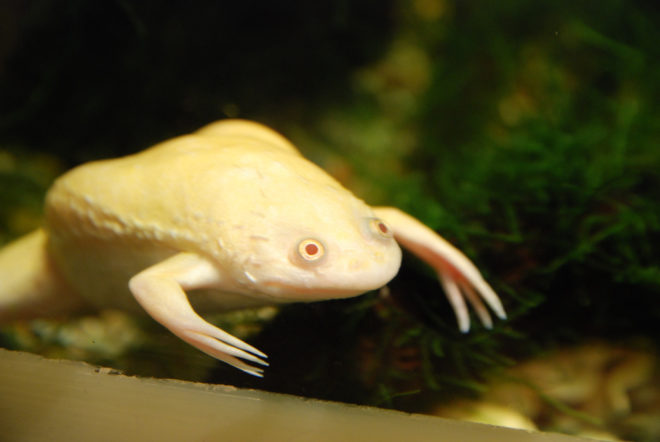The Pacman Frog is a colorful amphibian native to the South American continent, most commonly found in coastal forests and rainforests of the Columbian, Ecuadorian, Brazilian, and Peruvian regions. Their namesake corresponds to their resemblance to a Pac-Mac arcade character due to their round body and large, triangle-shaped mouth.
Their mouth will bite anything that moves, making them strictly “hands-off” pets. As pets, while they are to be handled with utmost rarity, they are pleasing to the eye and are a comparatively low-maintenance species. If you are thinking about getting one as a pet, this care sheet will provide you with everything you need to know about taking care of a Pacman Frog.
The Pacman Frog
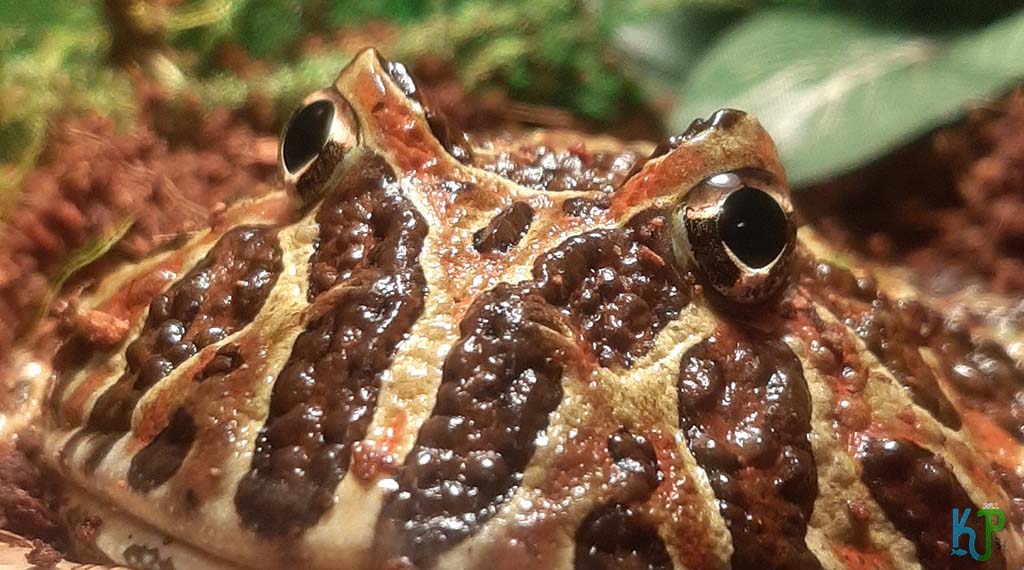
When you see a Pacman frog, there is no mistaking its appearance for another amphibian. Their wide mouths and horns over each of their eyes make them stand out. The latter has even earned them their additional namesake: the “horned frog.” Overall, 8 species of this frog have been discovered, all closely resembling each other in appearance.
The original discovery happened in Brazil in 1823, though it took until 1986 for the 8th, and more recent species to be identified. With the vast area of Brazilian rainforest not yet explored, however, it is entirely plausible that other Pacman frog species have yet to be identified.
The most popular Pacman frog pet species are the Cranwell, Surinam, and Argentine variants. They are as stunning to look at as their appetite is voracious. Not only can the Pacman frog consume smaller animals, but it can also eat ones that are nearly equivalent to its own size.
Interestingly, Pacman frogs are not aquatic, but rather, terrestrial, meaning that they align more with toads than the traditional frog. Most of its life is spent hiding in leaf litter, buried halfway underneath as it awaits its prey. Because hunting is easier at night, the Pacman frog is mostly active during nocturnal hours. Rainy seasons are the Pacman frog’s preferred time for breeding, so there is a lot more activity during daytime hours rather than during dry seasons.
Do Pacman Frogs Make Good Pets?
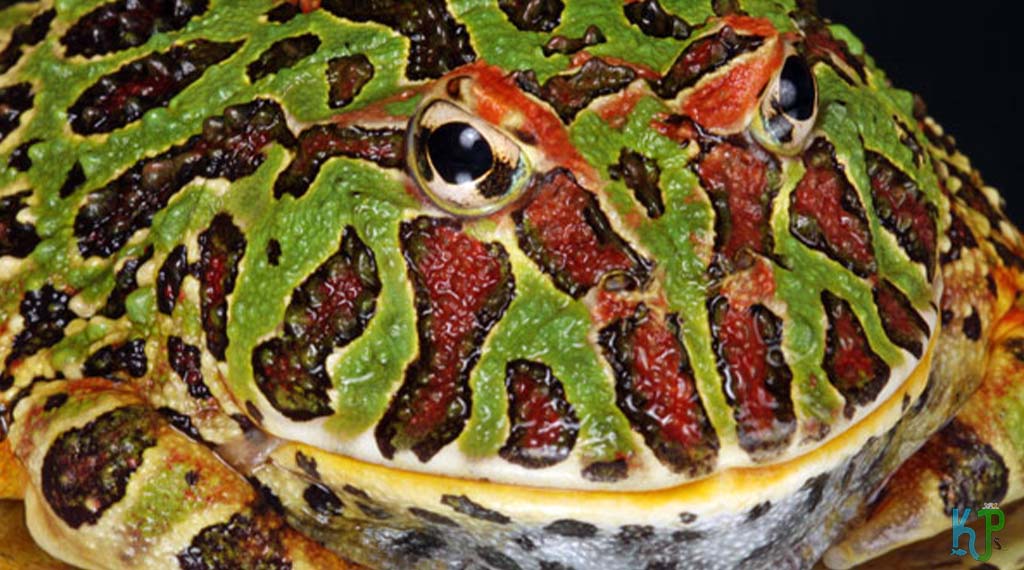
The Argentine, Surinam, and Cranwell’s Pacman frogs make terrific pets, especially for beginners. They quickly adjust to their new enclosure environment and do well with life in captivity. They need about 3 days to adjust, so once the frog is placed in its new domicile, it should be undisturbed for that time.
While handling this species of frog is discouraged, much can be learned from observing the creature. During the first few weeks, the Pacman frog will maneuver around the living space to seek out his or her favorite burrowing spot, which, when found, will be where the front spends the majority of its time.
The Pacman frogs come in a variety of different morphs and colorizations, so there are many options to choose from when picking your pet. Females particularly grow quickly and can be as large as 7 inches. The Pacman frog’s appetite and metabolism allow it to consume almost any type of food. Since they spend most of their lives in a sedentary manner, they don’t need a large living space to be comfortable and content.
What is not a good idea, however, is to cohabitate the Pacman frog with another frog species, as they get very aggressive toward other frogs in their living space. While you might find the frog burrowing during daytime hours, it is unlikely that you will see much activity from the animal unless you are watching it at night. As noted earlier, this is not a frog for handling. If done, this species is prone to bite aggressively.
The Pacman Frog’s Physical Appearance
The typical Pacman frog found in the wild will be of a muddy green or brown coloration, peppered with dark brown spots. As the frog ages, its colors and patterns change with age, so an adult Pacman frog might look entirely different than it did in its juvenile state.
Pacman Frog Types And Morphs
The three most popular species have a few relatively subtle differences. The Surinam horned frog has horns that are larger and more pointy atop a head of a solid brown hue. Their eyes are bright, and a horizontal stripe runs through their pupils. The Argentine horned frog has a square head with pointed horns, and is covered in blotches, and sometimes dark green or brown stripes on its body. Lastly, the Cranwell horned frog has a round snout, smaller horns, and a body covered with red or brown ovals or circles.
These are only three of the morph types of the Pacman frog. Captivity breeding allowed for more variants to spawn including the albino and the strawberry versions. The albino is distinguished by its yellow and pink pigmentation, as opposed to the brown and green, and is the most bred variation of the Pacman frog. Unlike the strawberry morph, it has a slightly greener hue and eyes that are light pink.
Pacman Frog Size
Overall, the Pacman frog is known for being stocky. Its skull is the majority of its body and is sturdy in nature. Its legs are also very robust. Overall, the Pacman frog can weigh just over a pound as an adult, but more traditionally it weighs in at about half a pound.
The male Pacman frog will grow to between 3 and 4 inches, while females can grow as long as 7. From the time they are a tadpole to the time they are a froglet, the progression is typical as with most other frogs, but afterward, their growth accelerates rapidly, as they reach their adult size in just over a year.
Caring For A Pacman Frog
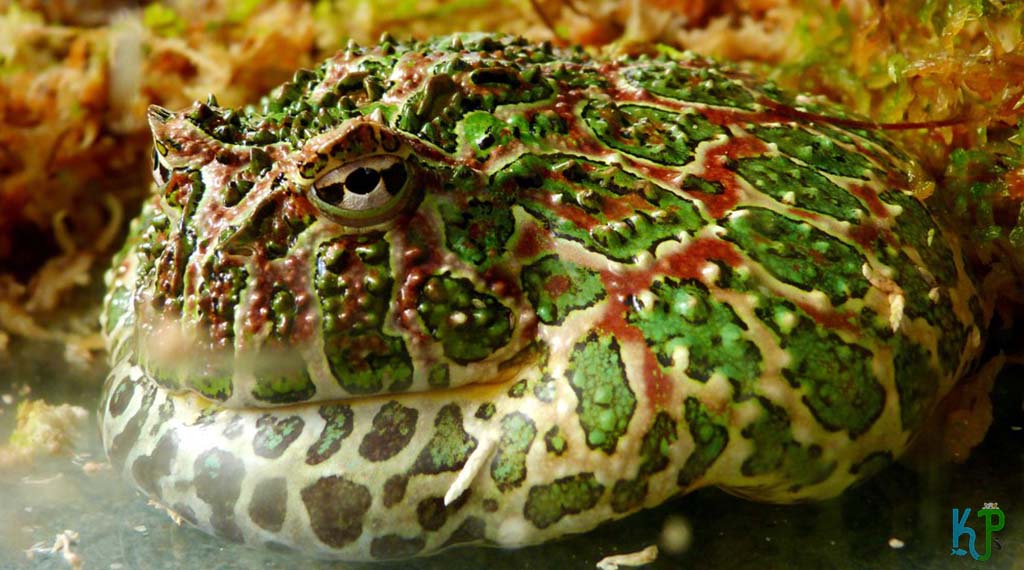
The Diet Of A Pacman Frog
The best way to describe a Pacman frog’s feeding habits is to refer to them as a carnivore by opportunity. In other words, while they eat other animals, they do not discriminate as long as the animal will fit into their mouths. They are passive hunters, sitting in wait while prey comes to them rather than actively pursuing it. Because of their brown and green mottled coloring, they can seamlessly blend with their leaf litter forest floor surroundings.
The easiest achievements for meals of the Pacman frog include mites and ants since they are plentiful and slow enough to spot, but they will consume much larger vertebrates like snakes, mice, and even other frogs. Those Pacman frogs living in captivity have diets that are a bit different. Froglets live on a diet of earthworms, crickets, and dubia roaches, with mealworms or wax worms as an occasional treat. The reason the latter is treated is that they are high in fiber and fat, so their intake should be limited.
Check our Pick for the best Pacman frog food: Zoo Med Aquatic Frog and Tadpole Food, 2-Ounce
How Often Should A Pacman Frog Be Fed?
Juvenile frogs should eat around 5 calcium powder-dusted roaches or crickets daily to help ensure the maintenance of sufficient Vitamin D3 levels. Figuring out how much food to feed your Pacman frog can be tricky at times, so the best suggestion is to feed it only as much as it will eat in 15 minutes, then remove anything that the frog has not eaten after such time.
As Pacman frogs mature to adulthood, their appetite wanes, so they will require feeding only every other day. Every two weeks an adult Pacman frog can be offered a pinkie mouse. As a safety measure, feed the frog with tongs because the animal is a voracious eater with a powerful bit which can result in painful injuries if fed by hand.
The Health And Lifespan Of A Pacman Frog
The Pacman frog lives for about a decade in captivity when they are well cared for and fed. In the wild, their lifespans are significantly shorter, lasting only 1 to 5 years on average.
The signs of a healthy frog include a round body, clear eyes, moist skin, and a healthy appetite. Most signs indicating poor health of a Pacman frog stem from poor husbandry or an inefficient diet, such as bacterial infections, vitamin deficiency, and metabolic bone disease. A deficiency of Vitamin A in a Pacman frog will cause its eyelids to swell, fluid to build up behind its back legs, and its skin can get course and rough. Gut-loaded crickets as part of the frog’s diet can help prevent such a deficiency.
If the frog is lacking Vitamin D3, its bones begin to experience metabolic degradation. This causes them not to be able to produce the calcium they need for strong bones, causing their arms and legs to be bent, resulting in a curved spine. When caught early, this can be treated with D3 sub-skin injections.
Pacman frogs are at high risk of bacterial infections due to the humid environment they live in and the thinness of their skin. Two of the most common bacterial illnesses are flavobacteriosis and red leg syndrome. Both conditions are caused by bacteria from unclean water or substrate and exacerbated by stress.
Setting Up A Pacman Frog Environment

The Pacman frog lives in forests, both dry and tropical, keeping close to tree roots, low branches, and other aspects that provide easy cover from predators, as well as hiding places from unsuspecting prey they are looking to ambush. They can also be found near little temporary water pools. Due to their natural environment being humid, the 2 pivotal factors to consider in setting up a Pacman frog’s living space are the substrate and the humidity.
Because the Pacman frog loves to burrow, its substrate should be nonabrasive and 3 to 4 inches deep to allow the creature to bury itself when needed. The best option for the substrate is coconut fiber because it is cost-effective to purchase, retains moisture, and is soft. It should be dampened, but not soaked, so if it is squeezed it should just yield a few water drops.
Insufficient moisture in the air prompts the Pacman frog to be dormant, which is bad for its health, leading to skin infections. The humidity levels for the animal need to be between 70% and 80%.
The tank should be either glass or plastic and ideally contain at least 20 gallons of volume, with the tank width being of greater importance than its height. An adult Pacman frog can live comfortably in a 30” x 12” x 12” glass tank, which is the preferred material due to easy viewing of the creature and the glass’s resistance to warming due to high humidity levels.
The frog’s natural environment is warm, so the tank should be kept at 77 F to 83 F during the daytime dropping down to about 70F to 75F during the night. If the tank is in a warm room, a heat bulb should be sufficient to heat the tank during the day, though heating mats under the tank are not recommended since it could cause burrowing frog burns.
Finally, the frog needs to have a shallow and wide water dish. It should be shallow enough to allow the frog to soak without becoming submerged. This is important since the Pacman frog is not a good swimmer and could drown in too deep of water. The bowl should be cleaned daily and refilled with chlorine-free water.
The Behavior Of A Pacman Frog
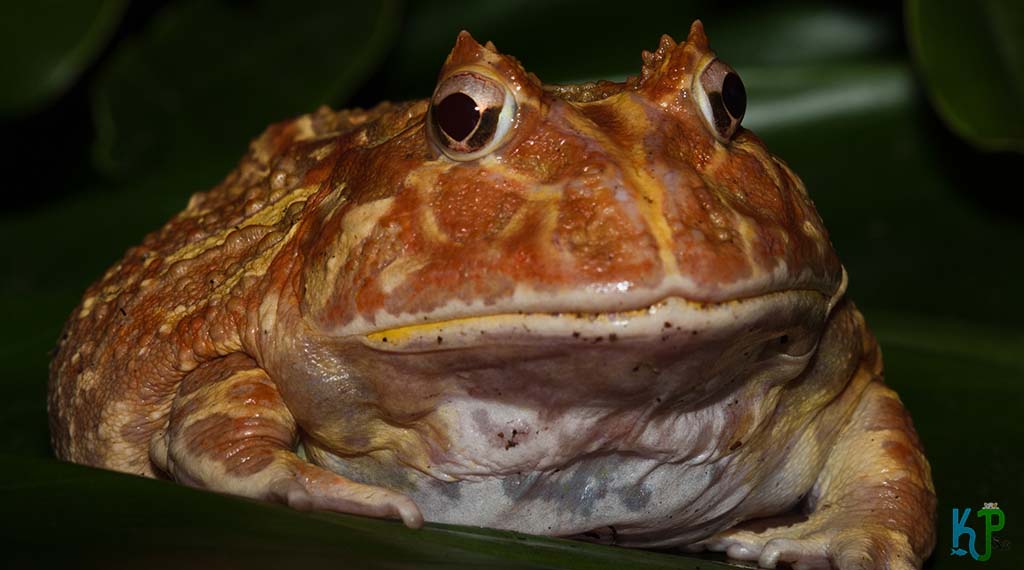
It is important to keep in mind the Pacman frog’s territorial nature, so they should never be kept in an enclosure with other creatures, including fellow frogs. They will bite them and cause serious injury or even death.
In the daytime hours, the Pacman frog will burrow in the substrate, either completely out of sight or partially, with the head visible. This is how the frog will spend the majority of its time during the day, as this is its most comfortable state. When they are active at night looking for prey, they will generally sit and wait for prey to approach them, so they don’t need a lot of room to maneuver around. But the frog will come out of the burrow at night to stretch, soak in the water, and explore, but the overall mobility will be limited.
Some owners get concerned when their frog had not moved for a couple of days, but unless other signs of illness or stress are present, they are perfectly fine. The only time the Pacman frog is truly active is when it pounds on its prey.
Should You Touch Pacman Frogs?
The Pacman frog should only be handled when absolutely necessary. Their thin skin absorbs toxins from the outside environment so bacteria from human hands can make them ill. They also are not conditioned to touch so they will view it as a form of aggression and bite, which is no joke since a larger member of the species can carry a 500 Newton-power bite. That’s like putting a weight of 112 lbs on your fingertip.
If the frog is held, hands need to be washed thoroughly before the frog is touched, and any perfumes, lotions, or other chemically based substances should be avoided before the frog is touched. If you do need to handle it, grasp the Pacman frog firmly behind the front legs. If the frog is bigger, hold your hands on the sides in a way one would hold a hamburger bun.
Purchasing A Pacman Frog
Typically Pacman frogs are sold as juveniles. The four most popular species are the Surinam, Argentine, Fantasy, and Cranwell’s horned frogs, and they can be found at most reptile expos, as well as from private breeders. When choosing a Pacman frog for a pet, look for open eyes, even skin, and all of its toes and fingers present. If they are not fully equipped, they may have been injured by another frog and could already be in subpar health. With the additional stress of moving to a new home, the frogs can quickly develop infections and perish. You should also request to see the frog eat, then choose the one that is the most enthusiastic eater.
A Pacman frog will generally cost between $15 and $30, though the Surinam species usually are more costly, with a price point between $45 and $60. More common morphs like the albino can cost around $35, while rarer types like pastel and teal will collect as much as $80.
Summary:
Pacman frogs are great beginner pets. They are beautiful in coloration and appealing to pop culture due to their appearance resembling an infamous video game character. With a correct tank setup and good husbandry, the Pacman frog can live for as long as 10 years.
It is entertaining to watch the frog’s eating habits, but they are mostly meant for viewing. Handling for the Pacman frog is discouraged due to their sharp teeth and powerful jaws that result in painful bites that they will happily issue for those trying to handle them.
Discover the unique needs of Albino African Clawed Frogs and learn how to properly care for them with our comprehensive guide. Don’t miss out, read now: Albino African Clawed Frog Care
Frequently asked questions:
What do pacman frogs eat?
Pacman frogs, also known as horned frogs, are carnivorous. They primarily eat insects, worms, and small invertebrates but can also eat small rodents and lizards in captivity. Providing a diverse diet to ensure they get all the necessary nutrients is essential.
How big do pacman frogs get?
Pacman frogs can grow up to 7 inches (18 cm) in length. They are relatively large and stocky frogs. Their size can vary depending on the specific species, with some being larger or smaller than others.
How long do pacman frogs live?
With proper care, Pacman frogs can live between 8-15 years in captivity. In the wild, their lifespan may be shorter due to environmental factors. It’s essential to provide suitable habitat and diet to ensure a long and healthy life for your pet Pacman frog.



